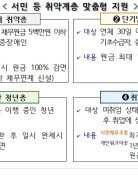A welcome but nervous rebound in marriage and births
A welcome but nervous rebound in marriage and births
Posted July. 25, 2024 07:19,
Updated July. 25, 2024 07:19
The number of births in May increased for the second consecutive month to 19,547. This is the first time in eight years and six months that the number of births has increased for two consecutive months. The number of marriages, a leading indicator of births, also increased by more than 20 percent for the second consecutive month, surpassing the 20,000 mark. Statistics Korea attributed the increase to people starting marriages that they had put off during the pandemic, which in turn led to a rise in births. The number of marriages has been rising steadily since August 2022. Given the time lag between marriage and childbirth and the fact that most births in South Korea occur among married couples, there are mixed expectations that the number of births, which fell to below 20,000 in May last year, may have bottomed out.
With the total fertility rate falling to 0.76 in the first quarter of this year, the increase in the number of births is like a welcome respite from the drought. Statistics Korea analyzed that the increase in the number of first marriages of people in their early 30s was due to housing support such as special supplies for newlyweds and marriage subsidies from local governments. In fact, the number of marriages jumped significantly in cities such as Daejeon, where newlyweds were given up to 5 million won (3,623 US dollars) in marriage subsidies, and Daegu, where they were given interest repayments for bank loans for lumpsum housing rental fee.
It remains to be seen whether the surprise rebound in the number of births is just the temporary phenomenon of base effect due to the COVID-19 pandemic, which caused marriage and births to plummet, or whether it will lead to a long-term trend. It would be good to see if the policies are working as described by Statistics Korea in a country where ‘no measures to boost births have been ineffective.’ However, it is difficult to make a hasty prediction. Cash handouts from local governments may encourage marriage and births in the short term, but their long-term effectiveness has yet to be proven. In addition, those born between 1991 and 1995, the prime marriage age, were born during a period when the number of births rebounded to 700,000 a year. It is possible that this is a technical rebound in the number of births due to more mothers.
The Organization for Economic Cooperation and Development (OECD) called South Korea the “world champion” of low fertility in its latest on the Korean economy. It also made a grim prediction that the nation’s population will halve in 60 years. “There is no silver bullet, so a comprehensive approach is needed,” OECD said, stressing the need for “broad structural reforms in the goods market and labor market, as well as completion of ongoing family policies.” This means that South Korea needs to remove obstacles to marriage, childbirth, and child-rearing gradually while accelerating structural reforms across our society that will reduce the pressure of excessive competition weighing on young people. Only by strengthening our resolve and speeding up structural reforms will South Korea be able to ensure that the rebound in marriage and childbirth will not be short-lived.






